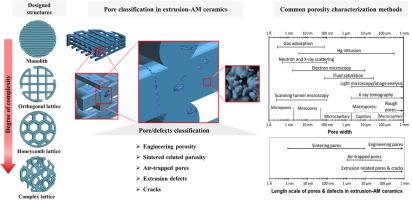Additive Manufacturing ( IF 11.0 ) Pub Date : 2021-08-31 , DOI: 10.1016/j.addma.2021.102272 L. Čelko 1 , V. Gutiérrez-Cano 2 , M. Casas-Luna 1 , J. Matula 1 , C. Oliver-Urrutia 1 , M. Remešová 1 , K. Dvořák 3 , T. Zikmund 1 , J. Kaiser 1 , E.B. Montufar 1

|
Direct ink writing, or robocasting, is an extrusion additive manufacturing technique for the fabrication of complex ceramic parts. Pores are common defects in post-sintered robocast parts that strongly influence the performance by changing the density, the transport properties, and the mechanical strength. In this work, the porosity (volumetric fraction, size distribution, geometry and topological distribution) of monolithic and 3D-lattice specimens made of hydroxyapatite was comprehensively characterized at multiple length scales through the six most widely used experimental methods for the study of porous materials. These two types of samples embrace the two most common types of additive manufactured ceramics and allowed the study of materials with pores in the submicron scale, as well as materials with a bimodal pore size distribution at significantly different length scales. Detected pores were divided into (1) engineered porosity set by the structural design, and (2) hollow defects, including intergranular porosity, trapped-air pores, cracks, and cavities, that overlapped at different length scales with the engineered porosity. The origin and mechanisms of formation of hollow defects are discussed, providing guidelines to avoid them. The experimental methods that allow discerning between pores and hollow defects are highlighted, and their advantages and drawbacks are discussed. This work might serve as a guide for the selection of the proper combination of methods for the pore evaluation of similar additive manufactured parts.
中文翻译:

通过挤压增材制造制造的陶瓷物体中孔隙率和空心缺陷的表征
直接墨水书写或机器人铸造是一种用于制造复杂陶瓷部件的挤压增材制造技术。气孔是后烧结 robocast 部件中的常见缺陷,它通过改变密度、传输性能和机械强度来强烈影响性能。在这项工作中,通过六种最广泛使用的多孔材料研究实验方法,在多个长度尺度上全面表征了由羟基磷灰石制成的整体和 3D 晶格试样的孔隙率(体积分数、尺寸分布、几何形状和拓扑分布)。这两种类型的样品包含两种最常见的增材制造陶瓷类型,并允许研究具有亚微米级孔隙的材料,以及在明显不同的长度尺度上具有双峰孔径分布的材料。检测到的孔隙分为(1)由结构设计设定的工程孔隙度,和(2)空心缺陷,包括粒间孔隙、困气孔、裂缝和空洞,与工程孔隙度在不同的长度尺度上重叠。讨论了空心缺陷形成的起源和机制,为避免它们提供了指导。重点介绍了区分孔隙和空心缺陷的实验方法,并讨论了它们的优缺点。这项工作可作为选择合适的方法组合以评估类似增材制造零件的孔隙率的指南。检测到的孔隙分为(1)由结构设计设定的工程孔隙度,和(2)空心缺陷,包括粒间孔隙、困气孔、裂缝和空洞,与工程孔隙度在不同的长度尺度上重叠。讨论了空心缺陷形成的起源和机制,为避免它们提供了指导。重点介绍了区分孔隙和空心缺陷的实验方法,并讨论了它们的优缺点。这项工作可作为选择合适的方法组合以评估类似增材制造零件的孔隙率的指南。检测到的孔隙分为(1)由结构设计设定的工程孔隙度,和(2)空心缺陷,包括粒间孔隙、困气孔、裂缝和空洞,与工程孔隙度在不同的长度尺度上重叠。讨论了空心缺陷形成的起源和机制,为避免它们提供了指导。重点介绍了区分孔隙和空心缺陷的实验方法,并讨论了它们的优缺点。这项工作可作为选择合适的方法组合以评估类似增材制造零件的孔隙率的指南。与工程孔隙度在不同长度尺度上重叠。讨论了空心缺陷形成的起源和机制,为避免它们提供了指导。重点介绍了区分孔隙和空心缺陷的实验方法,并讨论了它们的优缺点。这项工作可作为选择合适的方法组合以评估类似增材制造零件的孔隙率的指南。与工程孔隙度在不同长度尺度上重叠。讨论了空心缺陷形成的起源和机制,为避免它们提供了指导。重点介绍了区分孔隙和空心缺陷的实验方法,并讨论了它们的优缺点。这项工作可作为选择合适的方法组合以评估类似增材制造零件的孔隙率的指南。



























 京公网安备 11010802027423号
京公网安备 11010802027423号